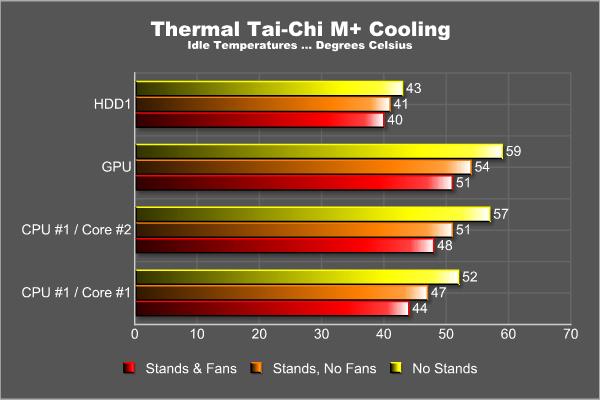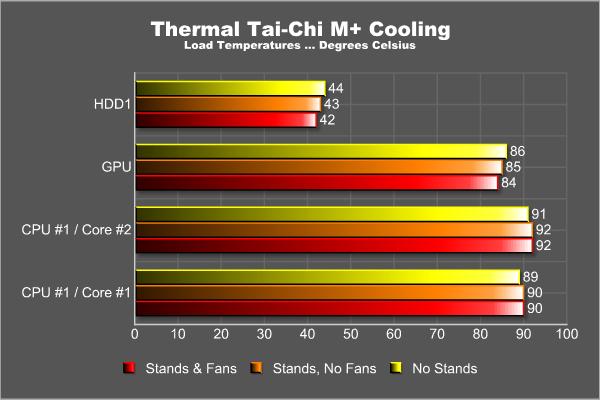Does your laptop’s bottom gets hot and burn your leg? If so, you definitely need to check out the Thermaltake Tai-Chi M+. Check out our review and see if this laptop stand can help you to prevent your legs from burning laptop.
INTRODUCTION
As notebooks become more powerful, they are also getting hotter. Many of today’s gaming notebooks are made with high performance CPU, dedicated GPU, and a fast 7200 rpm hard drive. These components offer excellent performance but also generate tremendous heat, something you don’t want to find on your notebook. Unlike desktop components, notebook components usually are not replaceable and even if they are, it is usually not easy to do by average users. Hence, the cooling of the notebook components are highly dependant on the level of craftsmanship used by the manufacturer. Unfortunately, due to the need to keep the notebooks light, sometimes it is not easy to offer the best cooling for all the top of the line CPU, GPU, and hard drives inside that one-inch portable unit.
This is why we have seen many manufacturers offer external notebook coolers. These external notebook coolers come in various sizes and forms. There’s active cooled notebook stands, which functions as a stand for the system and underneath the stand, there are fans where it will either blows or sucks air to help cool the system. There are also cooling pads, which are essentially made with material that can help cool the underside of the notebook by absorbing the heat away from the bottom of the notebook.
Thermaltake is a company primarily been known for their cases, power supply, and various cooling solutions. In addition to offer many CPU heat sink and fan and watercooling setup, Thermaltake also have many notebook coolers. We have received their Tai-Chi M+ notebook which we’ll put it through tests and see if it can help to cool the notebook components.
FEATURES
- Modernized black-silver aluminum extrusion pad.
- Design for 12”~17” wide-screen Laptop.
- Space-saving Folding design for easy storing.
- Ergonomic wrist pad design for maximum comfort.
- Adapter-free design; powered by notebook’s USB port.
- Dual silent 7cm fans(1000RPM.14dBA) with power switch.
SPECIFICATION
|
Model |
A2420 |
|
Weight |
1530 g |
|
Dimension |
400 x 330 x 35 mm |
|
Material |
Aluminum |
|
Fan Dimension |
70 x 70 x 15 mm |
|
Start Voltage |
4.5 V |
|
Power Input |
0.60 W |
|
Rated Current |
0.12 A |
| Bearing | Sleeve |
| Fan Speed | 1000 R.P.M. |
| Noise | 14.0 dBA |
| Accessories | USB 2.0 cable. |
THE COMPANY
Thermaltake Technology Co., Ltd. started its core business based on our extensive knowledge of PC thermal management during the era where the area of performance CPU cooling was only exclusive for “overclockers” orPC enthusiasts. With the company’s initial launch of Orb coolers, it created waves of shocks and appraisals throughout the gaming and overclocking communities. Thermaltake quickly became the name gamers turn to when they need high-end and reliable thermal solutions.
With company’s core business of CPU cooling still growing at a vast rate, Thermaltake made another grand entry to the PC chassis industry. To date, Thermaltake has always been considered as the pioneering company that revolutionized the PC chassis industry with Xaser series enclosures. The typical and traditional beige and plastic front panel design was outdone by Xaser series chassis’s atypical gaming red and aluminum front panel. It was also the first enclosure available to public with Hardcano unti which provided users full control over computer’s thermal management system.
In the year 2002, Thermaltake announced Purepower line of power supply unti for the ever-growing power-hungry PCs. Purepower series PSU quickly gained recognition with its extensive warranty and high-reliability guaranty.
Today, Thermaltake has grown into a world-class company with state-of-the-art testing and R&D facility based in Taiwan along with 60+ engineers and ID team covering each application segment such as Liquid Cooling, Air Cooling, PC Enclosure and Power Supply for main-stream users, high-end solutions, system integrators and industrial applications; thus achieve Thermaltake’s company motto, ” COOLall YOUR LIFE ” !
CLOSE LOOK AT TAI-CHI M+

Thermaltake actually has two model of Tai Chi notebook cooling stands, the Tai Chi M and Tai Chi M+, and today, we will be looking at the Tai Chi M+ version. The Tai Chi M+ is slightly longer than the Tai Chi M (400 mm vs 320 mm), thus, it is also slightly heavier (1530 g vs 1233 g). In addition, the Tai Chi M comes with tetractable stationery tray. Other than these, the two coolers are virtually identical.
The Tai Chi M+ comes in a small box that is just slightly larger than the stands itself and on the outside of the box, you will see detailed information about the product.
Opening up the box and you will find that the notebook stand is protected with two pieces of Styrofoam cutout. Inside, we find the Tai Chi M+ notebook stands, an USB cable, and a manual.
Let’s take a closer look at the Tai Chi M+. The unit measures 400 x 330 x 35 mm (LxWxH). The Tai Chi M+ is made with entirely aluminum. The metal body of the Tai Chi M+ is nice as metal conducts heat much better than plastic, so it should help to cool the notebook slightly better; however, metal also is heavier than plastic, so the Tai Chi M+ weighs in 1530 g. This makes it hard to carry the Tai Chi M+ with you.
The Tai Chi M+ is foldable for easy carrying and storage. There’s a palm rest area which also serves as a support for the notebook, so the notebook won’t slides off the stand. On the bottom of the stand, you will see rubbers which help to prevent scratches.
It’s hard to see from the picture, on the edge of the palm stand, it’s is rubberized to prevent any scratching on the notebook.
Looking as the sideway, we can see that the stand is tilted at approximately 10 degrees. The tilt angle is not too steep and makes it easier on the eyes and work with the notebook when the notebook is placed on the stands.
Underneath the stand, we will find two 70 mm fans. The fans are rated at 1000 rpm with 0.60W of power input. The fans are powered vis the USB connector on the notebook and Thermaltake has included two USB ports on the stand, one for powering the fans and the other for USB device so the USB connector on the notebook won’t be tied up with the fan. We see there’s also an on/off switch for the fan.
TESTING AND RESULT
I test the Thermaltake Tai-Chi M+ with my Macbook Pro, which is known to run very hot. The Macbook Pro has two fans located on the left and right side of the notebook toward to the LCD screen’s hinge. The fans are designed to blow hot airs away from the internal components.
I have decided to do three separate tests. I test the notebook sitting on top of a desk, on the Tai-Chi M+ without the fan, and on the Tai-Chi M+ with the fan. The load and idle temperatures are recorded with the system running with Boot Camp v1.4 in Windows XP Professional and 3DMarks06. The temperatures are recorded with Everest. Based on my personal experience, the Macbook Pro runs hotter under Windows than under OS X, thus the result will show the worst case scenario.
Here are the results:
Under the idle condition, we see that the Tai-Chi M+ is able to reduce the CPU temperature for about 6 degrees without turning on the fan. With the fans on, the temperature of the CPU is being reduced for three degrees even further. The GPU is also being reduced as well with the Tai-Chi M+, 5 degrees (without the fan) and 8 degrees (with the fan). The hard drive has not been reduced to much, only couple of degrees. It is understandable as the hard drive for the Macbook Pro is located on the front of the notebook, underneath the palm rest, so it’s far away from the rear exhaust fan of the notebook and the two 70mm fans on the Tai-Chi M+. I am slightly surprised to find out that raising the notebook with the Tai-Chi M+’s aluminum body is actually quite efficient in reducing the temperature of the notebook and the fans are just able to further reduce for a few degrees.
The Load condition temperature is quite interesting. While we see a fairly good cooling effect from the Tai-Chi M+, with the system running under load, the Tai-Chi is unable to keep the internal components cool even with the fans turned on. The result is quite disappointing.
It seems to me that the aluminum body and the tilted surface are what help the Tai-Chi M+ to cool the notebook; while the two fans are providing only small added cooling.
CONCLUSION
The Thermaltake Tai-Chi M+ is a nice product for keeping the notebook cool. The tilted stand, aluminum body, and two quiet 70mm low rpm fans, all work well in keeping the notebook running cooler. Not only it functions as a notebook cooler, it can be used as a stand for the notebook due to the tilted surface. Unfortunately, it’s too heavy and not compact enough to be carried around.
In order to achieve maximum cooling ability, the notebook’s fan placement and the location of the internal components are important for the Tai-Chi M+. This notebook cooler is probably best suited for notebooks with either intake or outtake fan on the bottom of the notebook near where the stand’s fans location. It may also be a good choice for a less powerful system on the market which will not generate as much heat under load as the Macbook Pro that was used in this test.
Pros:
+ Tilted stand
+ Constructed with aluminum which helps to dissipate heat
+ 2 quiet 70 mm fans
+ Foldable for easy storage
Cons:
– Does not work well with all notebook
– Heavy to be carried around
– More USB port is appreciated
 Bjorn3D.com Bjorn3d.com – Satisfying Your Daily Tech Cravings Since 1996
Bjorn3D.com Bjorn3d.com – Satisfying Your Daily Tech Cravings Since 1996













